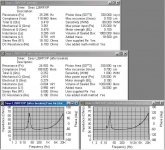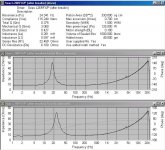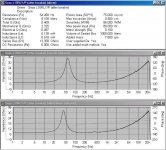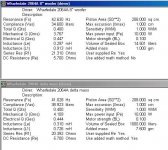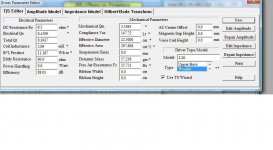I am using SpeakerWorkshop to measure my drivers via the delta mass method. Problem is estimated Qes and Qms (therefore Qts) are way too low. Vas is also too low for my larger L26 driver.
The two drivers I've measured are a Seas L15 and Seas L26. Both drivers don't appear to have any mechanical issues (ie. no rubbing or scraping noises when driven to excursion) and have been broken in for about 4 hours each using 1/3rd octave warble tone centered on 30Hz with a +/- 10Hz warble offset.
The L15 measurements look reasonable, although Q is too low.
The graph below is the L26. Here's the stats
manufacturer T/S params
Qms = 2.15
Qes = 0.39
Qts = 0.33
Vas = 171 litres
my measured T/S params
Qms = 2.615
Qes = 0.279
Qts = 0.252
Vas = 108 litres
The bottom two impedance curves are Free Air (left) with added mass (right) from the after breakin measurements.
At first I thought the mass I calculated was wrong. Of course a smaller calculated mass than actual used will result in a larger Vas, however I'm using coins with (I assume) reasonably accurate weights. Even if they are off, to get the Vas into the approximate region (ie. 171 Litres for the L26 instead of 108 shown after breakin below), I need to put in about 2/3rd of the actual weight used in the calculation (ie,. I added 36gms of coins so put in about 22 gms into SW to get Vas = 168 litres. The coins simply cannot be that much out).
Any ideas?
Is my breakin period not long enough?
Am I not driving the woofer hard enough to properly breakin? (I doubt it as I believe it is being driven close to its 7mm xmax).
Is it possible to have a Q lower (in my case I believe significantly lower) than the manufacturers after breakin?
You might notice the weight used for before and after breakin differs. I tried doubling the weight after breakin to see if that made a difference, Vas however was still in the low 100s.
Thanks,
David.
The two drivers I've measured are a Seas L15 and Seas L26. Both drivers don't appear to have any mechanical issues (ie. no rubbing or scraping noises when driven to excursion) and have been broken in for about 4 hours each using 1/3rd octave warble tone centered on 30Hz with a +/- 10Hz warble offset.
The L15 measurements look reasonable, although Q is too low.
The graph below is the L26. Here's the stats
manufacturer T/S params
Qms = 2.15
Qes = 0.39
Qts = 0.33
Vas = 171 litres
my measured T/S params
Qms = 2.615
Qes = 0.279
Qts = 0.252
Vas = 108 litres
The bottom two impedance curves are Free Air (left) with added mass (right) from the after breakin measurements.
At first I thought the mass I calculated was wrong. Of course a smaller calculated mass than actual used will result in a larger Vas, however I'm using coins with (I assume) reasonably accurate weights. Even if they are off, to get the Vas into the approximate region (ie. 171 Litres for the L26 instead of 108 shown after breakin below), I need to put in about 2/3rd of the actual weight used in the calculation (ie,. I added 36gms of coins so put in about 22 gms into SW to get Vas = 168 litres. The coins simply cannot be that much out).
Any ideas?
Is my breakin period not long enough?
Am I not driving the woofer hard enough to properly breakin? (I doubt it as I believe it is being driven close to its 7mm xmax).
Is it possible to have a Q lower (in my case I believe significantly lower) than the manufacturers after breakin?
You might notice the weight used for before and after breakin differs. I tried doubling the weight after breakin to see if that made a difference, Vas however was still in the low 100s.
Thanks,
David.
Attachments
Tried again - this time using a new clamping technique. Driver was not moved / reclamped between measurements. First was free air, then weight was added. This time I added 49 gms to ensure the Fs was lowered more at least 25%.
Another possibility is my sound card is having problems measuring frequencies below 20Hz accurately enough for T/S calcs. I might have to use the delta compliance method.
The graphs look cleaner (no humps / bumps around Fs indicating vibrating weight on the cone, reflections or other movement). So I think these are the cleanest plots I am going to be able to make with the delta mass method.
Another possibility is my sound card is having problems measuring frequencies below 20Hz accurately enough for T/S calcs. I might have to use the delta compliance method.
The graphs look cleaner (no humps / bumps around Fs indicating vibrating weight on the cone, reflections or other movement). So I think these are the cleanest plots I am going to be able to make with the delta mass method.
Attachments
Here's the L15 measurement.
Much closer to manufacturers specs and what Zaph measured for his L15 samples (albeit a few years ago) here (L15 T/S table at bottom of web page):
http://www.zaphaudio.com/audio-speaker12.html
Much closer to manufacturers specs and what Zaph measured for his L15 samples (albeit a few years ago) here (L15 T/S table at bottom of web page):
http://www.zaphaudio.com/audio-speaker12.html
Attachments
Ok, maybe I am being paranoid, or my Vas accuracy goes down with increasing driver Vas.
Here for example is an 8" woofer. First set of T/S params are delta compliance measured in a 14.5 litre box. The second are delta mass with 7.6 grams added.
Vas in both cases is pretty similar
Here for example is an 8" woofer. First set of T/S params are delta compliance measured in a 14.5 litre box. The second are delta mass with 7.6 grams added.
Vas in both cases is pretty similar
Attachments
I have seen several cases where the Cms value is pretty far off the datasheet value. This typically results in a higher fs and smaller Vas.
Several manufacturers of drivers are reducing the cost of their drivers, and that can result in eg stiffer Cms and also different cone break-up behaviuor. I recently saw this in a Peerless driver. I don't know about Seas, though.
Anyway, the value of Cms is usually not as critical as one might think. Cms has the greatest effect below the system resonances, and this range is usually the least interesting in loudspeaker design. This is not always easy to understand when looking at "high level" parameters, such as Vas, Qts and fs. A variation in Cms affects them all, and the co-variation leads to rather small differences above fs. In this case it might be easier to understand the effects through Mms, Cms and Rms/Rme instead.
Several manufacturers of drivers are reducing the cost of their drivers, and that can result in eg stiffer Cms and also different cone break-up behaviuor. I recently saw this in a Peerless driver. I don't know about Seas, though.
Anyway, the value of Cms is usually not as critical as one might think. Cms has the greatest effect below the system resonances, and this range is usually the least interesting in loudspeaker design. This is not always easy to understand when looking at "high level" parameters, such as Vas, Qts and fs. A variation in Cms affects them all, and the co-variation leads to rather small differences above fs. In this case it might be easier to understand the effects through Mms, Cms and Rms/Rme instead.
Thanks Svante,
Well - I did a few more hours breaking in, and different mass and results are very similar - infact Vas hasn't moved at all.
Previously after 3 hours of breakin:
Fs = 24.34Hz
Qts = 0.375
Qms = 3.06
Qes = 0.42
Vas = 115.2 litres
with 49gms mass added
After another 4 hours breakin
Fs = 24.39Hz
Qts = 0.389
Qms = 3.166
Qes = 0.44
Vas = 115.2 litres
with 38gms mass added
One more test... I'll get out the other L26 and see how that compares.
Otherwise, I'll conclude my L26's have a much smaller Vas than published and will design accordingly.
Cheers,
David.
Well - I did a few more hours breaking in, and different mass and results are very similar - infact Vas hasn't moved at all.
Previously after 3 hours of breakin:
Fs = 24.34Hz
Qts = 0.375
Qms = 3.06
Qes = 0.42
Vas = 115.2 litres
with 49gms mass added
After another 4 hours breakin
Fs = 24.39Hz
Qts = 0.389
Qms = 3.166
Qes = 0.44
Vas = 115.2 litres
with 38gms mass added
One more test... I'll get out the other L26 and see how that compares.
Otherwise, I'll conclude my L26's have a much smaller Vas than published and will design accordingly.
Cheers,
David.
I am in the middle of a seas project using the L26 and the vas is around about 142 Litres from memory.
Would you like me to post my T/S Parameters when I arrive home later on ?
Also my delta mass was 76grams.
Would you like me to post my T/S Parameters when I arrive home later on ?
Also my delta mass was 76grams.
Hi oldbar,
Yes thanks to posting your T/S params. That would be helpful.
I did get a 144 litre Vas at one point, but that was a one off, while hand holding the driver. I threw the measurements away thinking it was an erroneous measurement.
Out of interest, could you please post a little about your project with the L26, especially your enclosure type and xo point and low pass slope for the L26.
Cheers,
David.
Yes thanks to posting your T/S params. That would be helpful.
I did get a 144 litre Vas at one point, but that was a one off, while hand holding the driver. I threw the measurements away thinking it was an erroneous measurement.
Out of interest, could you please post a little about your project with the L26, especially your enclosure type and xo point and low pass slope for the L26.
Cheers,
David.
Hi Oldbar,
I also notice your Q and Fs are in the same region as mine.
I think your Vas is artificially high. Your effective area is 397cm2 - when the L26 is actually 330cm2 (you have to remove the phase plug area from the overall cone area measurement). This would result in an inflated Vas calculation.
For example - if I set my Sd to 397cm2 - I get Vas = 166 litres (not 115).
Cheers,
David.
I also notice your Q and Fs are in the same region as mine.
I think your Vas is artificially high. Your effective area is 397cm2 - when the L26 is actually 330cm2 (you have to remove the phase plug area from the overall cone area measurement). This would result in an inflated Vas calculation.
For example - if I set my Sd to 397cm2 - I get Vas = 166 litres (not 115).
Cheers,
David.
Dave Bullet said:Hi Oldbar,
I also notice your Q and Fs are in the same region as mine.
I think your Vas is artificially high. Your effective area is 397cm2 - when the L26 is actually 330cm2 (you have to remove the phase plug area from the overall cone area measurement). This would result in an inflated Vas calculation.
For example - if I set my Sd to 397cm2 - I get Vas = 166 litres (not 115).
Cheers,
David.
In soundeasy from what I understand the effective diameter is measured from about 1/3 of the rubber surround and that is is entered into soundeasy when you do the TS parameters.
The effective area is what Soundeasy calculates when it is doing the TS parameters.
You now have me wondering if I am doing something wrong myself but i have checked on Zaphs website to compare the L18 and my measurements are like his.
Hi oldbar,
I think Soundeasy will only be able to calculate effective area from the diameter or radius you enter. Unless I am completely wrong, I believe you have to account for the phase plug and subtract that from your cone area. you would then fudge soundeasy by giving it a diameter (or radius) so it derives the same area (unless soundeasy allows you to enter phase plug radius / diameter as well).
For example, the L26 cone diameter from inner edge to outer edge surround is 210mm. The phase plug diameter is approx 46mm. Subtract the phase plug area from the overall area and you get approx 329.5 cm2 (seas posts 330cm2). I don't have an L18 to measure diameter so can't tell whether Zaph took that into account for the L18. His calculated Sd is however 6 cm2 larger than Seas quoted (132cm2 vs. 126cm2).
Cheers,
David.
I think Soundeasy will only be able to calculate effective area from the diameter or radius you enter. Unless I am completely wrong, I believe you have to account for the phase plug and subtract that from your cone area. you would then fudge soundeasy by giving it a diameter (or radius) so it derives the same area (unless soundeasy allows you to enter phase plug radius / diameter as well).
For example, the L26 cone diameter from inner edge to outer edge surround is 210mm. The phase plug diameter is approx 46mm. Subtract the phase plug area from the overall area and you get approx 329.5 cm2 (seas posts 330cm2). I don't have an L18 to measure diameter so can't tell whether Zaph took that into account for the L18. His calculated Sd is however 6 cm2 larger than Seas quoted (132cm2 vs. 126cm2).
Cheers,
David.
Maybe you need to adjust your markers in Speaker Workshop? The default for impedance measurements are 20hz to 1khz. 20hz is pretty close to your measured fs, which could be screwing up the analysis.
Try looking at the results of your calibration measurements to guess how low you can go. My Audiophile 2496 soundcard seems to be great down to 5hz, and usable down to 2hz.
Dan
Try looking at the results of your calibration measurements to guess how low you can go. My Audiophile 2496 soundcard seems to be great down to 5hz, and usable down to 2hz.
Dan
Dave Bullet said:Hi oldbar,
I think Soundeasy will only be able to calculate effective area from the diameter or radius you enter. Unless I am completely wrong, I believe you have to account for the phase plug and subtract that from your cone area. you would then fudge soundeasy by giving it a diameter (or radius) so it derives the same area (unless soundeasy allows you to enter phase plug radius / diameter as well).
For example, the L26 cone diameter from inner edge to outer edge surround is 210mm. The phase plug diameter is approx 46mm. Subtract the phase plug area from the overall area and you get approx 329.5 cm2 (seas posts 330cm2). I don't have an L18 to measure diameter so can't tell whether Zaph took that into account for the L18. His calculated Sd is however 6 cm2 larger than Seas quoted (132cm2 vs. 126cm2).
Cheers,
David.
I do have the L18 here and my measurement are the same as Zaphs .
I did not think that the phase pug had to be taken into account as i though you only take into account the measurement form side to the other.
If you had to take in account the phase pug then that would be the same with a dustcap as well.
I think you take the dust cap into account because it is part of the piston moving air (ie. attached to the cone - not the former). In the case of a phase plug - it is fixed and therefore not contributing to the air movement, therefore not counting as part of the cone (piston).
Thanks,
David.
Thanks,
David.
Hi Dan,
Sorry - I missed your post. Great suggestion. I completely forgot about the impedance marker. I'll move it down and see what happens.
Thanks,
David.
Sorry - I missed your post. Great suggestion. I completely forgot about the impedance marker. I'll move it down and see what happens.
Thanks,
David.
I was just wondering how did you go when you measured your second driver.
I redid my measurements for the L26 and ended up very close to your vas taking in to account the phase plug.
If you like I will posts mine later on this afternoon.
I redid my measurements for the L26 and ended up very close to your vas taking in to account the phase plug.
If you like I will posts mine later on this afternoon.
Hi oldbar.
that is encouraging. I've got the 2nd L26 on the bench now having a workout, so when its done, I'll measure and let you know.
Out of interest, I measured a crappy 8" woofer from jaycar I had lying around - and got exactly the manufacturers published Vas, so I think my techniques are ok.
In addition to the coin weight itself I estimate I use about 1/2 gram of bluetack per coin.
Cheers,
David.
that is encouraging. I've got the 2nd L26 on the bench now having a workout, so when its done, I'll measure and let you know.
Out of interest, I measured a crappy 8" woofer from jaycar I had lying around - and got exactly the manufacturers published Vas, so I think my techniques are ok.
In addition to the coin weight itself I estimate I use about 1/2 gram of bluetack per coin.
Cheers,
David.
AFAIK, there are only 2 methods - both result in a change in Fs. If you mean delta compliance, it is actually harder as you need an appropriate sized sealed box with an appropriate sized driver hole and a gasket to seal.
Delta mass (adding known weight to the cone) may not be as accurate (?) but it is a lot easier to setup.
Cheers,
David.
Delta mass (adding known weight to the cone) may not be as accurate (?) but it is a lot easier to setup.
Cheers,
David.
- Status
- Not open for further replies.
- Home
- Loudspeakers
- Multi-Way
- Delta mass - Vas too small
